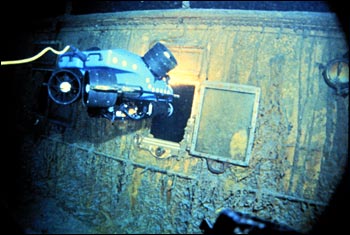How to Discover a Shipwreck In 5 Easy Steps

Scientists have explored less than 4 percent of the world's ocean floor. Imagine all the sunken treasures they're missing! If listening to Celine Dion and watching yet another Pirates of the Carribean flick won't quiet the booty-hunter in you, follow these steps to find a shipwreck of your very own. (Note: You're gonna need a boat.)
Step 1. Volunteer
Honestly, you probably don't know what you're doing, so it's best to first hook yourself up with professionals. Woods Hole Oceanographic Institute (WHOI), the National Oceanographic and Atmospheric Administration (NOAA), Scripps and the University of Washington are all big players in deep sea and shipwreck exploration. There are also a number of smaller organizations, like the nonprofit Waitt Institute and the UK's commercial Blue Water Recoveries.
Figure out who's going where and email them (repeatedly) to see if you can volunteer as a crewmember. Or throw wads of money at them — missions are always looking for funds before they can go looking for anything else.
Either way, don't expect a luxury cruise. Try for expeditions in the Caribbean or near Hawaii where there are islands (and beaches, naturally) that may offer more time on shore. Or, stay Stateside: Sony just sponsored an expedition in Lake Huron that uncovered a sunken schooner from 1889. Indeed, there are hundreds of ships strewn along the bottom of the Great Lakes.
Step 2. Find the haystack
The ocean is a big place and a shipwreck may as well be a needle, Dave Gallo, director of special projects at Woods Hole, told Life's Little Mysteries. So first, you've got to find the haystack, the section of sea where the ship you seek sank.
Sign up for the Live Science daily newsletter now
Get the world’s most fascinating discoveries delivered straight to your inbox.
If you're looking for an 18th Century Spanish galleon that went down ages before the rise of GPS, that might mean a lot of detective work, which will involve hitting the books and scouring archives to learn all you can about the vessel. If the ship (and its cargo) is valuable today, chances are it was valuable back then, too, which means someone was keeping track of its movements in and out of ports, when it went missing and the haul it had onboard.
Step 3. Turn on the lights
It's pitch black down on the ocean floor, so there's no eyeballing it, even if you're talking about something as big as the Titanic. You can scan large swaths of area with wide-range sonar to identify where something of interest might be. Get yourself an AUV, or automated underwater vehicle, and attach to it a sonar sensor that can send sound waves out to about half a mile on either side. Then set course to "plow the field," or "mow the lawn," as oceanographers say, going back and forth on a precise route to efficiently cover your area of investigation.
Moving at about 2 or 3 miles per hour, you can search nearly 20 square miles of sea floor in a day. The images you get back from the sensor are really fuzzy, so you'll need a sonar operator onboard to analyze them and separate what's a likely shipwreck from what's just the craggy surfaces of some of the Earth's most rugged mountains and deepest valleys.
Step 4. Look for the needle
Once you've zeroed in on your target, zoom in for a closer look with short range sonar for better detail. Lower the instrument down on a remotely operated vehicle (ROV). Control your swimming robot from the surface as it sends back live instant images via a cable, to map out a blueprint of the object including jagged edges, chains and the terrain around it.
Better yet, send down a camera to capture real-time video. Low voltage lamps for lighting the scene only go about 50 to 70 feet underwater, but what you lose in range you make up for in resolution. On the last trip to the Titanic, the crew (including WHOI's Gallo), shot the ship in live 3-D HD.
Step 5. Plunder
Once you've got a solid lay of the land, get on down there. It costs about $50,000 per seven-hour day to drive around in a manned submersible, so you want to be sure you know what you're doing and what you're planning to get. Subs are equipped with exterior manipulators that can grab objects from the wreckage. Pilots have to be very skilled to handle delicate artifacts, and special adapters sometime have to be customized for certain antiquities.
Finally, surface triumphantly with your loot. But, please, be sure to declare whatever goods you reclaim. Pocket just one measly doubloon and you might as well be a pirate.
This story was provided by Life's Little Mysteries, a sister site to LiveScience. Follow Life's Little Mysteries on Twitter @llmysteries, then join us on Facebook.
Why is yawning contagious?
Scientific consensus shows race is a human invention, not biological reality










